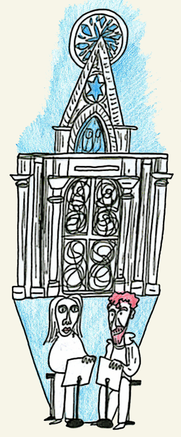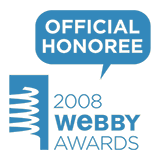Emdashes—Modern Times Between the Lines
The Basics:
About Emdashes | Email us
Ask the Librarians
Best of Emdashes: Hit Parade
A Web Comic: The Wavy Rule
Features & Columns:
Headline Shooter
On the Spot
Looked Into
Sempé Fi: Cover Art
New Yorker Festival: T. Coraghessan Boyle and Mary Gaitskill
Filed under: On the Spot Tagged: Angel Orensanz Center, Anthony Hopkins, books, fiction, Joshua Leonard, Mary Gaitskill, Matthew Broderick, movies, New Yorker festival, nyfest, Pollux, short story, T. Coraghessan Boyle, T.C. Boyle

Pollux writes:
This year marked my first-ever New Yorker festival. It was also my first time in New York City, unless I count a stopover on the way to South America and the time I was there to mark my second birthday.
More momentous than my second birthday, which involved plucking buds off a large potted plant in a hotel lobby, was my introduction to my first event at the festival: short-story readings by T. Coraghessan Boyle and Mary Gaitskill.
The Angel Orensanz Center is a beautiful venue, a Gothic Revival synagogue whose upper reaches were illuminated by a soft blue light, giving the impression that one was in the open night air. Candlelight illuminated the stage, which was occupied by the two literary luminaries.
Gaitskill went first, and read the touching “Don’t Cry.” Boyle then read his funny story The Lie.
The moderator, Branden Jacobs-Jenkins, joked that the shared theme of the evening was “Babies in Danger”: Gaitskill’s story featured a character named Janice facing dangers in Addis Ababa as Janice’s girlfriend attempts to adopt a baby in the city, while Boyle’s “The Lie” is about a man who plays hooky from work by claiming that his baby has just died.
In the Q&A session following the readings, Gaitskill remarked that writing novels for her is a more difficult process than writing stories, since novel-writing leads to a tendency to go all over the place, like “a confused dog in a field.” She commented that with a short story, she could “aim her brain” in order to compose a shorter, and tighter, piece of work.
The two authors were also asked about the act of reading their stories in front of an audience. Boyle said he likes to read stories that have a complete story arc. He added that he never writes anything for the specific purpose of reading it before an audience, but that the actual rhythm of the words as they are read aloud is just as important as their meaning. He likes to give a good show: “Art is entertainment.”
For Gaitskill, public reading is an opportunity to turn impersonal words into a performance. As she pointed out, public reading uses our most primitive musical instrument of entertainment: the human voice.
With public reading, Gaitskill said she can directly relate to her audience, and customizes her readings to specific audiences. She likes to emphasize certain words depending on her audience, making certain words harder or softer, for example.
Both authors were asked about the film adaptations based on their work. Gaitskill talked about Secretary, which was adapted from one of her stories (the initial short story idea was inspired by a newspaper clipping) and the frustrations and challenges surrounding it.
There was a discussion on internal dialogue, which in a book can be represented or described. In a film, internal dialogue is, for the most part, sacrificed, sometimes to the detriment of plot or the larger meaning of the original work.
It was commented that moviemaking, ultimately, is a group project. The writer has to live with the sometimes dramatic changes involved in the metamorphosis from book to film.
As Boyle, whose novel The Road to Wellville, was adapted into a film starring Anthony Hopkins and Matthew Broderick, aptly put it this way: a film is just a like a musician doing a cover of another artist’s song. It’s just a version, and you can’t control it.
Boyle revealed that “The Lie” will also be turned into a film. According to this blurb, it will be directed by Joshua Leonard of Humpday fame.
It was a stimulating evening, and a great introduction, for me, into the minds and mentalities of the participants (both audience and presenters) involved in the 2009 New Yorker Festival.




